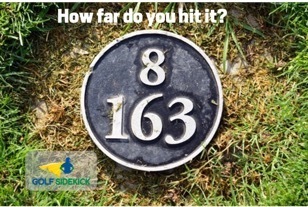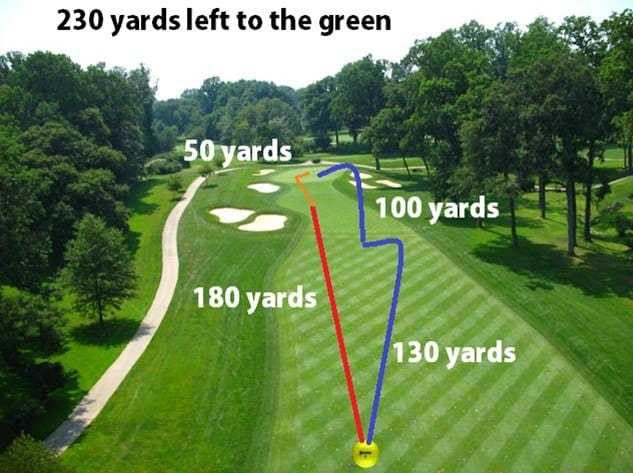Last Updated on December 26, 2023 by Matt Greene
Have you ever shot 43 on the front nine and thought, wow I only need 46 on the back side for an 89!
And what happens next is tragic. You shoot 50 for a 93. The beer doesn't taste the same. You think about leaving your wife, giving up golf, and becoming the next Jack Reacher. Don't let that be you by going through this guide to how to break 90 in golf time and time again.

What if I could show you how to break 90 in golf consistently?
Because there is, and I'm going to show you steps to take IN YOUR NEXT ROUND to actually do it. No theory, all action. All killer, no filler.
I put together my experience over 25 years on the course from being a new golfer lusting after an 89 to being the guy on the YouTube channel guiding people to under 90 scores regularly. This is how you break 90 in golf consistently.
The EXACT strategy to break 90 often
Anyone can break 90 and in this guide and I'll show you:
- The exact shots you need to be able to play from tee to green
- The way to think and plan your way around the course for success
- How to practice the concepts at the range
- Shortcuts and 'hacks' to break 90 faster than you thought possible
There's no need to make swing changes. If you can shoot in the 90's, you can break 90 without changing your swing. What I'm going to show you are basic fundamentals and tricks that you may or may not have come across before. Good luck!
The FIVE shots you NEED
You need to have a core group of shots that you can call on when you play golf. Breaking 90 is not pretty and it's not like the pros on TV. You must be able to execute a small number of strokes, and lean on YOUR strengths.
SHOT 1: Reliable club that goes 160 yards or MORE off the tee
We'll use this club off the tee on every single hole except par 3's where we might need another club. This club does not need to literally fly dead straight. It needs to be a golf club that gets you into play away from trouble every time.
DO NOT MISUNDERSTAND: We need a minimum of 160 yards. You must select your MOST RELIABLE long club.
Select any club in your bag that you feel most comfortable with to hit 160 or more yards - the longer, the better of course. This could be your fairway wood, hybrid, driver or 5 iron. Whatever club it is, it must be consistent and straight. You should use this off the tee most often.
Your goal is just to hit fairways off the tee and allow for a stress-free second shot. We are looking for bogeys to break 90, there's no need to hit the ball as far as possible. In fact, if you are hitting the ball too hard, you are doing this all wrong.
We just need fairways with a decent enough distance to clear the rough before the fairway starts. With this tactic, we'll make bogeys but along the way, a few pars too!
Example: When I was first broke 90, my go-to club off the tee was a 5 wood. It had a reliable shot-shape and I could hit it nicely 9 out of 10 times with confidence.
SHOT 2: A solid pitching game inside 70 yards
We always try to avoid 30-70 yard pitch shots on the course as much as we can, but they'll inevitably happen. So you must learn to play them because they'll save you three or more shots per round because you want to hit the green from here.
You must select the club that you love to use.
It can be a Lob wedge, Gap wedge, Sand wedge or Pitching wedge - whatever you perform best with. I like to use a Sand Wedge or a Lob Wedge.
This will take some practice but there's a great way to learn how to judge these shots and build confidence. The system is based around the arms of a clock.
In this Dave Pelz video on the the short game, the guru shows how to actually do it. It works - I've been using this system for the last 10 years and this one technique took me into the single digit handicaps. In the video he talks about using this for all your wedges, but don't worry too much about using multiple clubs for now. Learn to control the distance with one wedge first. We want to simplify this as much as possible.
SHOT 3: Your 2 favorite clubs from inside 150 yards
Select TWO clubs you know you can hit on the green from 150 yards or less. Just two. And the choice is up to you - whatever you like the most!

Mine are my pitching wedge from 120 to 130 yards and a gap wedge from 105-115 yards.
I may hit it longer or shorter than you, but that doesn't mean anything. If you feel confident to hit 6 out of 10 greens with an 8 iron from 120 yards and pitching wedge from 100 yards, that's perfect.
You're going to use these two clubs for your final approach shots to greens.
For instance, you might have 240 yards to the green after your drive on a very long par 4. You know you can't reach so what we're going to do is break the distance into two shots.
You need to be thinking 'how can I place my ball so that I hit my FAVORITE iron into the green for my 3rd shot?'
For example what I did in the video you'll see below was take a 240 yard shot and think 'I love hitting my pitching wedge from 120. 240 yards is two shots of 120 yards! Perfect! Two nice pitching wedges irons and I'm on the green. This works MUCH better than a 3 wood into the rough and a difficult 50 yard pitch shot from the deep grass!
Warning: Be prepared, people will think you're weird, but guess what - you're going to break 90 this way baby! Without question. Split your long approaches into shorter approaches and watch your partners crumble in front of your eyes when you break 90 easily!
Warning 2: I do not mean you must split every shot into exactly 2 shots. If you have 200 yards into the green, and love a 50 yard wedge shot, you should hit your 150 yard club and then your 50 yard pitch shot. The way you play must suit YOUR game.
SHOT 4: A consistent two-putt and a solid short putt
Three-putts are score killers. Everyone can two-putt. It's just a matter practice.
Hit the practice green after work once or twice a week for 30 minutes to an hour and you'll see your scores dropping. If you cannot hit the practice green, putt on a putting mat!
Our aim is a PFP - Putt For Par. We just need to get onto the greens with a putt for par regardless of the distance from the hole. So if you can make one or two for par, that's a bonus. But be happy with a two putt bogey every time as well!
A lot of people will see a reliance on putting in my guides. This is true because it is the only area in the game where we ALL can be as good as pros. You do not need perfect technique, nor massive power. Everyone can be good inside 100 yards.
SHOT 5: One club to chip with around the greens

Select a club you like to bump-and-run chip with. This must be a club that you can consistently chip onto the green with a confident stroke, and get it rolling to the hole. The flop or lob shot is too difficult at this stage of your development, and too inconsistent for guys trying to break 90. You'll skull and fluff too many which is where you lose instant strokes with a 60 degree.
I've always loved the pitching wedge to chip with and I've used it as long as I can remember. Select yours and practice with this one club whenever you can on a chipping green or even at home. Check out the practice routine in the practice section below.
Remember the goal of chipping is not always to chip it CLOSE when you break 90. The goal is to get the ball on the green first. That means no dropping the toiletry bag and leaving it short of the green with another chip on the way. Be aggressive enough to GET THE BALL ON THE GREEN SOMEWHERE! One day we will start chipping to HOLE everything. But for now, let's get it on for a putt.
VERY IMPORTANT: You must understand chipping entails landing the ball so it can roll out to the hole. We almost never try to land the ball AT the hole. If you chip it to land in line with the hole, it will bounce and roll a long way, leaving you long putts. Imagine a chip as if you are just getting it onto the green to roll like a putt.
BONUS: An Excellent Pre-Shot Routine
Something that is overlooked is the pre-shot routine. Think of when you take a shower. Maybe you start with a rinse, then in this order you wash your hair, ears, face, arm pits, do a little twirl with your arms in the air, then its onto the front, sack back and crack then the bottom of your feet.
Now if you don't do it like that on one particular day, you might feel a little weird - like you've forgotten something and it'll be on your mind all day. That's the same thing with a pre-shot routine. It helps you to be at ease and forget anything else besides this next shot.
But not all pre-shot routines are created equal.
Swashbuckling flamboyant 'just-because' swings of the club are pointless. You can be practicing bad habit! When you perform your pre-shot routine, have a super clear vision in your mind of the shot you're about to hit. Always have a plan in your mind. Always envision the shot and the shot thereafter.
I only realized I had this problem in 2015 after playing golf for 17 years. I just swung practice swings without any purpose like Jack Sparrow with his sword. Can you believe that?
Implementing important shots to break 90
You'll notice in the explanations below that all you need to break 90 are the 5 shots I've suggested above whether it's long par 4's or short par 5's.
Par 3's
These holes are all reachable in one shot if you're playing off the correct tees.
You should look to be on or near the green on par 3's. Be happy with bogeys here and be sure to get on the green in one shot, or maximum two shots. On long par 3's look for a safe area to land the ball, where if you miss the green, you'll have an easy chip onto the green. When you identify this place, purposefully hit it there.
Don't be a hero and go for the green if you can't reach. A bogey is actually a good score.
Par 4's
Shorter par 4's are your target to try hit the green in two shots.
If a par 4 is only 300-350 yards, you can hit it on or around the green in two shots.
If you practice hitting the club we selected above for tee shots, you'll be in positions to hit the short par 4's in two.
On longer par 4's try to be on the green in three shots. For example on a 450 yard par 4:
Hit the club that we selected above that goes longest and straightest off the tee (160+ yards)
You'll have 280 yards into the green. How can we get to your favorite club (8 iron from 130) into the green? We need to hit one shot 150 yards and that will leave 130 yards. So you hit 6 iron 150 yards.
Now you have 130 yards into the green and you can hit your favorite shot into the green for your third.
After you hit the green or just miss it, now you need to get in the hole in two or fewer shots. Easy!
Par 5's
A couple of the par 5's will be reachable for you in three shots. Try to hit one or two of them in three shots. It's not always possible but when you see a par 5 that's 480 yards, that's only 160 yards per shot and you can definitely reach that!
There's no need to boom drivers either if you're not accurate. Always remember that the Par 5 is now a par 6. You can always take 4 to get onto the green and a 6 is a great score.
How to Break 90 - Shot by shot video of an 87
I took everything you've read above and put it into practice to show you how to break 90 with some tips and fundamentals along the way. It's about 20 minutes long. You'll find some tips and instruction in the video and I believe if you follow similar steps and work on the keys to breaking 90, you can do it within 8 rounds.
Each shot was recorded once and no retakes were allowed. I shot it in Malaysia at the Kukup Golf Resort.
My tee shots on all par 4 and par 5 holes: SIX IRON (175 yards)
My favorite approach shots: PITCHING WEDGE (120-130 yards) & GAP WEDGE (105-115 yards)
My chipping club: PITCHING WEDGE
My pitching club: SAND WEDGE
How to practice these 5 essential shots
Go to the driving range for the tee, approach and 30-70 yard pitch shots
Remember your selections from the previous section? Take only those clubs to the driving range. Try find a grass driving range because the artificial turf gives you good shots even if you hit the ball fat.
Here's an example (remember these choices are up to you):
Armed with only these 4 clubs, go to the driving range and run through a full 18 holes on your home course. Tee off with a vision of the hole in your mind and use the driving ranges flags or signs or fairway to identify where you need to hit the ball to 'hit the fairway'. This is way more fun than just beating balls like a robot.
Remember: Take your time on each shot throughout your imaginary round. Do your full shot routine. Take a 2 minute break between hits. Don't ever rush your driving range time. Consciously program the feelings you are getting from the shots and actually feel your confidence building up inside you.
Corniest (but most effective) driving range tip you'll ever hear: When you hit a good shot on the driving range with one of your 4 clubs, pretend to take that shot inside your hand and then deposit it into a pocket in your golf bag like fairy dust so you can take it out the bag on the golf course when you need it. I know I sound like an idiot now, but try it! It actually works!
Get to a chipping and putting short game practice area
Go to your local range, golf course or golfing mecca and practice your chipping and putting. If you don't have any of these things, practice in your yard and if your yard is too small, practice in your house and if your house is too small, take a break for two weeks, then give up golf completely:
- Chipping: We're going to practice bump and runs where the ball lands on the greens and runs out to the hole. Low skidders, flop shots and all the fancy things you see on Tour will get you to either make an 8 or actually kill another human being with a skulled chip. I highly recommend placing a coin on the practice chipping green then try to land the ball on your coin with your chipping club. I've always used a pitching wedge for green side chips and the secret to getting it close is to pick a spot to land it and then land it on the spot. It takes practice like anything but it's just that simple.
- Long putting: practice with 4 or 5 balls putting the ball to within 3 feet: the closer the better.
- Short putts: Put 5 or 6 balls around one hole 5 feet away from the hole. Practice keeping your head down until you hear the rattle of the ball in the hole. You must make all the putts in a row before you can move to another hole. Become lethal at 5 foot putts and you'll break 90 in your sleep.
Quick Hacks and Tips to Break 90
If you've made it this far, well done. Because the next few concepts below will make the biggest difference to your score. You WILL break 90 by following these guidelines.
You may be shocked just how many shots under 90 you end up shooting.
Select the correct tees

You probably could've broken 90 already if you played off the correct tees!
How do you know which ones to pick? There are a couple of ways to select your tee box:
Calculate your tee box by your driver distance
Average drive distance multiplied by 28. So if your average drive is 230 yards, a challenging length of a course should be 230 yards x 28 = 6,440 yards maximum. So a range of between 6,000 to 6,600 yards.
Calculate your tee by number of par 4 over 400 yards
If there are too many par fours over 400 yards on the course you play, move up a tee.
What if everyone else is playing off longer tees?
Fuhgeddaboudit! Hey man, stay strong, it's your game and you're there to have the most fun. No one minds if you play off shorter tees during social rounds! If you're in a good mood because you're enjoying your game and that makes it more fun for the other guys, they really don't care. But if you're playing poorly and getting in a bad mood off the longer tees, then it'll make it more unpleasant for them
Learn how far you REALLY hit the ball

Those 300 yard drives the guys boast about? The pitching wedge that goes 160 yards? Those are unicorns and they might hit 1 out of 20 that distance. Scale back the ego and learn how far you REALLY hit your clubs MOST OF THE TIME. With your rangefinder or GPS watch telling you the distance, you can select the correct club and hit more greens.
This is such an underestimated factor in playing better golf. I can't stress enough how important it is to hit enough club on your approaches to lower your score and break 90 and even 80. Many guys use that one perfect shot they hit to gauge their club distances and never revisit their calculations.
If your perfect 7 iron goes 175 yards but you hit it 165 yards MOST OF THE TIME, then use 165 yards as your 7 iron distance. By using the 175 yards, you handicap yourself by very often being 10 yards short of the target which means more chips, more bunker shots and higher scores. You'll need to do this for every club in your bag but once you get past the dent in your ego, the better scores make up for the pain, believe me.
Get a golf rangefinder and learn to use it to break 90
I was always the guy who scoffed at a rangefinder. I was pacing the distances and guessing but then I played with my friend Dietmar who uses a rangefinder. I double checked my distances and I was always off and sometimes by 10 yards. That explains why I was always one club short of the green and chipping all the time.
So I got one. And I don't know how I lived without it. Check out the Voice Caddie L5 rangefinder. I love mine.
How to use it:
From the tee: measure distances to bunkers and hazards and select a club you can swing fully without worrying about reaching them.
From the fairway: measure to the pin and measure carry over water by shooting the bank. Shoot to find the distance to the front edge or carry over bunkers by shooting the lip with the rangefinder.
Calculate your distance: You can also shoot the rangefinder from where your ball is, back to the place you hit from to get an accurate gauge of the distance. This is incredibly valuable information. Scorecards and distance markers can be off depending on the day and your rangefinder will give you 100% accurate distances.
Armed with this info, you can adapt and learn your game as you go. Without this knowledge, you're doomed to keep repeating the same errors in selecting clubs and hitting less greens.
Another option is to get a golf GPS watch that has a feature to count your distance as you walk. Something like the Garmin S40 is a good choice.
Think like an 80 golfer - one step ahead
The difference between an enlightened golfer and a frustrated golfer is this one concept. You need to be thinking about the shot AFTER the shot you're hitting. This means you should be thinking where the shot you're hitting is likely to end up, and what you'll do after that. Below are two quiz questions to illustrate this:
Example 1: How do you approach the green to break 90?

You must know your favorite club to hit into a green. It's important to understand which is your favorite iron for approach shots and from what distance. I have two: pitching wedge from 130 or a smooth 53° Wedge from 100-110 yards.
Answer:
Now that you know your favorite club, hit a shot that will make your next shot the distance to the green where you can hit that favorite club.
So instead of booming a fairway wood 180 or 190 yards and leaving yourself a VERY difficult 40 or 50 yard pitch, rather put yourself into a position to hit the best club in your bag onto the green with confidence! The results will astound you.
In the picture above, I would hit my pitching wedge 130 yards and then hit my 53° wedge onto the green. I am so confident with it, I can almost guarantee I'll hit it to 10 feet or less.
For you it might be a 6 iron followed by an 8 iron. Or a 5 iron followed by a sand wedge. It's totally up to you, but find the club you love to hit into greens and if you find yourself in a position where the green is out of reach, split the remaining distance into two shots, leaving your favorite shot into the green!
Example 2: Where do you aim to break 90?

Answer: Aim for 'A'
If you aim at B and hit it short or with a fade, you'll end up in the bunker and that's a nasty bunker shot. Aiming at C means you can hit the ball other side of the bunker and need to chip over the bunker to get onto the green. There's also a chance of hitting it in the bunker. Too much danger!
Aiming at 'A' means you can leave it short or even hit a draw and be in a position to chip the ball with a lot of green to work with and the ground is flat to the left without a big drop off like the right side. If you hit a little fade, the ball will land between your target and the pin but a straight shot will also be on the green just a bit further away. There is no danger hitting it at 'A' and is the high percentage play. You'll probably hit the green and two putt or chip and two putt for a bogey. That's all you need to break 90!
Golden nugget: Play for your shot shape but always aim to a position where even a straight shot won't be in danger and never hit a ball toward a hazard. So in the picture above: if you hit a fade, you aim at 'A' and if it fades, it's in a good spot. If it goes dead straight, it's still in a good position.
Commit to every shot
How many times have you addressed a golf ball and thought 'this isn't enough club' or 'this just feels like too much club'?
These little thoughts destroy your game because you hesitate when swinging and don't take a confident swipe at the ball.
It's essential, vital, paramount to have a vision in your head of what your shot will look like and what the result will be. If you're not sure where the ball is gonna go, redo your pre-shot routine and GET THE VISION! Then say to yourself 'this is the right club and it'll land on the right side of the green where I can putt for a birdie'
Golden nugget: When you have any thought in your mind other than the shot you're playing while addressing the golf ball, step away and reset. This takes discipline and is difficult to do at first but the benefits are amazing. Start implementing this strategy today!
Common thoughts that make me step away:
- My glove feels like it's slipping
- My right foot feels higher than my left
- I wish this guy would stop talking
- My girlfriend really over-reacts to small things
- There's no way I can carry the water with this
- This sweat droplet is going to run into my eye in the next 0.05 seconds!
Simply back off, go through the pre-shot routine again and focus on the shot. Get a different club if you're not sure. Wipe your sweaty hand on your towel. Whatever it takes. It only happens a few times a round, but avoiding these bad situations where you hit a poor shot through lack of concentration will help you break 90 quicker than you thought possible.
If you ever play golf with me, you'll see me take another pre-shot routine and talk to myself out loud because my first one was a pointless swinging of the club like a fool. I take another two swings imagining a nice high fade with the driver and I say out loud, 'that's the one I want, let's hit that shot, easy' and 90% of the time, it comes out how I want.
100% of shots I'm not committed to end in disaster. Without exception.
It doesn't matter if you're a scratch golfer or a newbie, committing 100% to every single shot is the key to great golf.
Warm up before the round to score below 90!
Warming up properly and making a good swing from the first tee is vital to get a good start and break 90. Being 8 over par after 4 holes sucks and is difficult to come back from.
Long game warm up
You probably sit at a desk all day and have turned into Quasimodo like I did. Don't tee off with cold Quasimodo muscles - warm up any way you know how because you know it's going to take you 4 holes to warm up properly. No good! I used to do it and it meant I was playing catch-up for 14 holes to shoot a good score.
If you have a driving range at your course, hit 20 balls. Hit four shots with each of the following in this order:
1. Your favorite wedge x 4
2. Your favorite iron x 4
3. Your favorite hybrid x 4
4. Your favorite fairway wood x 4
5. Your first tee shot club. You should stop hitting when you hit a perfect shot with this club even if you have balls left. Take that positive feeling to the tee.
Bonus tips to start scoring in the 80s
DO NOT count up your score relative to par as you play
This is one of the most important ideas on this list and essential to breaking 90. The only way to break 100, 90 or 80 is to never count up your score until the end of the round. You can keep score but don't add it up halfway, in your head or otherwise. Just wait til the clubhouse and add it up there.
Neither I, nor any of my golfing buddies have broken through a score barrier while counting up the strokes throughout the round.
Pick a par 70 golf course
I broke 90 and 80 on the same golf course - a par 70. Breaking 90 is a mental barrier and when you've done it once, it happens more and more regularly. Choosing a course with a par of 70 means you can shoot 19 over for an 89. That's two extra strokes you can take compared to a par 72 where you need 17 over to break 90.
This isn't a requirement, but a simple idea that could help you get over the hurdle.
Play with better players
We all have our best golfing buddies and some of us are lucky to have good players as buddies. But often we get stuck playing every round with guys who aren't interested in progressing.
If your golfing partners are not as good as you, I highly suggest finding a group to play with sometimes where you're the worst player in the group. It doesn't have to be a huge difference in skill level but at least guys who shoot mid-80's every round (10 to 15 handicappers).
You might think better players don't want to play with higher handicappers, but that's not true. We're all a brotherhood on the golf course and with a good attitude and fun chit-chat, we'll play with anyone.
Playing with better players will let you take a bit more time on your shots, because the other guys do. You'll care more about each shot, because they care about their shots. You'll notice how they approach each hole and how they score in the 80's which will rub off on you and you'll be shooting mid 80's in no time.
Join a matchplay league
If you have a matchplay competition league in your area or in your club, join up. You'll be forced to play against other people to progress in the league but the other golfers will be in your handicap range so they'll be moderately better or equal to you. The extra focus and determination when competing against other guys will improve your scores.
Find a relaxing habit
Do you get tense on the golf course? Do you grip the putter with white knuckles or wring the club's neck? Tension kills tempo and accuracy - both of which you need to get below 90.
A quick tip to relieve the tension is to have a relaxing habit. That can be putting a tee between your teeth to relieve jaw tension or it could be chewing gum to get the neck muscles and jaw loosened up. Find yourself something that will relieve tension on the golf course for those days when you're feeling extra edgy.
Get in the zone
Before you even get to the course, you're probably thinking, 89 is just 17 bogeys and 1 par on a par 72 track. That's the advice everyone gets. While it's true and you should understand that, it's not really a strong mental game plan. We'll show you later how to use that idea to create an on-course strategy.
The best tip to get in the zone is to attach no value to the end result. It's difficult but the easiest way to break 90 is to have fun. Enjoy chatting with your buddies. Have fun being away from the women. Just immerse yourself in the golf experience and realize how lucky you are to be able to enjoy this hobby.
Take your medicine when you find trouble
Isn't it strange how we get to the ball deep in trouble and think we can hit it on the green through a small gap in the trees? I mean trees are 80% air, right?
But 95% of the time, we screw it up and have a blow out hole. If you want to break 90, you need to eliminate blow out holes (doubles or worse). If you find yourself in the trees, just get the ball out to a place you can play the next shot easily.
Try get on the green and make a putt or 2 putt for a bogey or maximum double bogey. Triples and quadruples are killers! Always look for the easiest most obvious route and silence that inner Seve Ballesteros!
Frequently Asked Questions about Breaking 90
Can I break 90 without a driver?
Yes. You only need a club that you can trust to go straight and hit the fairway. The only requirement is that the club can carry 160 or so yards to get you onto the fairways. In fact, it's easier to shoot 90 with a hybrid, 5 iron, 7 iron, wedge and putter than with 14 clubs. Leave the driver at home if it doesn't put you in a good position 90% of the time.
How many golfers can break 90?
According to the USGA, 59% of golfers play off a handicap of 15 or below. That is usually someone who can break 90. But that's handicapped golfers. If we include every golfer that plays more than 5 times in their life, I would estimate only about 40% of golfers could break 90 in their lives. Unless of course, they follow my guide. Then I think 80% of you can!
Do I need lessons to break 90?
If you can shoot between 90 and 100 you don't need a lesson. Lessons can be great value to teach you how to do things properly, but if you can hit a golf ball in the air every shot, all you need to do is practice, use the techniques and tips I've given you here and check out some more guides I put together like the putting, chipping, pitching, using the driving range and fitness guides.
I would actually say getting fitter and more flexible will improve your golf equally as much as practicing the shots.
Conclusion
Please leave a comment with any other tips you've found to improve your game and if you disagree with anything I've mentioned here let me know. Good luck and enjoy shooting in the 80's.
You will do it if you follow this guide and check out my Youtube playlist on breaking 90. I promise.


